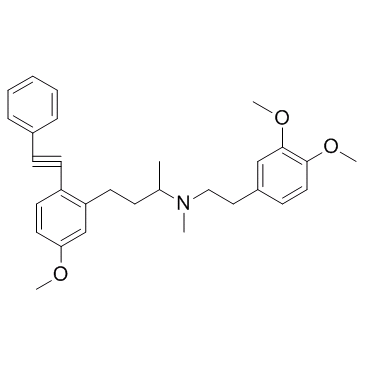99254-95-2
| Name | McN5691 |
|---|---|
| Synonyms |
N-[2-(3,4-Dimethoxyphenyl)ethyl]-4-[5-methoxy-2-(phenylethynyl)phenyl]-N-methyl-2-butanamine
Benzenepropanamine, N-(2-(3,4-dimethoxyphenyl)ethyl)-5-methoxy-N,α-dimethyl-2-(phenylethynyl)- Benzenepropanamine, N-[2-(3,4-dimethoxyphenyl)ethyl]-5-methoxy-N,α-dimethyl-2-(2-phenylethynyl)- n-[2-(3,4-dimethoxyphenyl)ethyl]-4-[5-methoxy-2-(phenylethynyl)phenyl]-n-methylbutan-2-amine |
| Description | McN5691 is a voltage-sensitive calcium channel blocker. |
|---|---|
| Related Catalog | |
| Target |
Calcium Channel[1] |
| In Vitro | McN5691 (1 and 10 μM) prevents 60 mM KCl-induced contraction and calcium uptake and causes concentration-dependent relaxation (EC50=190 μM) of 30 mM KCl-contracted aortic rings. At or below 10 μM, McN5691 (McN-5691) has no effects on basal tone or calcium uptake (45Ca) in isolated rings of rabbit thoracic aorta. McN5691 causes complete high affinity inhibition (Kd=39.5 nM) of specific diltiazem binding to the benzothiazepine receptor on the voltage-sensitive calcium channel in skeletal muscle microsomal membranes. In contrast to diltiazem, McN5691 inhibits specific dihydropyridine receptor binding, but the effect is biphasic with high (Kd=4.7 nM) and low (Kd=919.8 nM) affinity components. McN5691 inhibits norepinephrine (NE)-induced contraction (10 μM) and calcium uptake (1 and 10 μM) and causes concentration-dependent relaxation (EC50=159 μM) of 1 μM NE-contracted rings of rabbit thoracic aorta[1]. |
| In Vivo | The excretion and metabolism of a 2-ethynylbenzenealkanamine analog, antihypertensive McN5691 (RWJ-26240), in beagle dogs is investigated. A total of 96.8% and 2.8% of the radioactive dose are excreted in feces and urine, respectively, during the 7 days after oral administration of 14C-McN5691. Of the radioactive dose, 96.8% and 2.8% is recovered in feces and urine, respectively, in the 7 days after oral administration of 14C-McN5691. More than 87% of the dose is excreted in feces during the 48 hours. McN5691 is extensively metabolized in dogs. Unchanged McN5691 is found in less than 0.1% and 19% of the dose in the 0-24 hour urine and 0-48 hour fecal extract, respectively, and 36% of the sample in the 4 hour plasma[2]. In the McN5691 (McN-5691) study, vascular resistances tend to be higher in spontaneously hypertensive rat (SHR) than in Wistar-Kyoto (WKY) but the differences are statistically significant only in the cerebellum and the midbrain[3]. |
| Animal Admin | Dogs[2] 14C- McN5691 is administered by gavage to male and female beagle dogs (3 of each sex, weight 10.2-12.8 kg) as a single 6 mg/kg (as free base in corn oil) dose. Plasma samples are obtained for 24 hours after dosing. Urine and fecal samples are collected over a 7-day period. Each collected sample is assayed for total radioactivity and analyzed by TLC and HPLC. Rats[3] Studies are conducted in male SHR and control normotensive Wistar-Kyoto (WKY) rats. All animals are housed in constant temperature and environment facilities and given standard lab chow and water ad libitum. Four separate studies are conducted using conscious, age-matched animals:(a) SHR receiving McN5691 as a hydrochloride salt (McN5691) (n=8, body weight=361±7 g); (b) SHR receiving vehicle (VH) (n= 8, bodyweight=381±5g); (C) WKY receiving McN5691(n=9, body weight=355±7 g); and (d) WKY receiving VH (n=6, body weight=342±7g). McN5691 or VH alone is administered i.v. (right jugular vein) as a 15 min continuous infusion for each dose. Each animal receives three doses of McN5691 (0.3, 1.0 and 3.0 mg/kg) in a cumulative fashion or VH infused at an equal rate (0.0408 mL/min). |
| References |
| Density | 1.1±0.1 g/cm3 |
|---|---|
| Boiling Point | 595.6±50.0 °C at 760 mmHg |
| Molecular Formula | C30H35NO3 |
| Molecular Weight | 457.604 |
| Flash Point | 156.4±27.3 °C |
| Exact Mass | 457.261688 |
| LogP | 7.36 |
| Vapour Pressure | 0.0±1.7 mmHg at 25°C |
| Index of Refraction | 1.590 |
